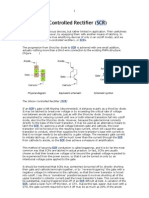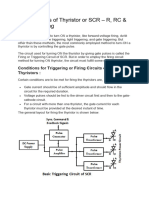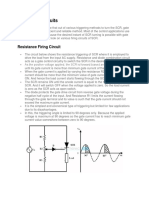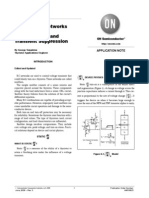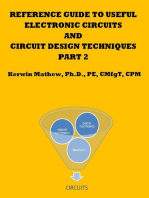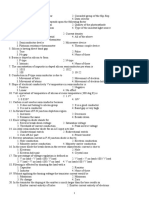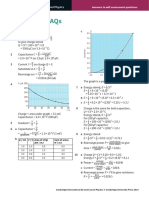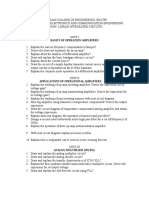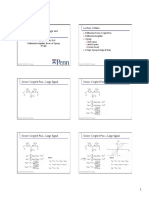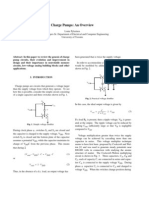Design of Snubber Circuits For Thyristor Protection
Design of Snubber Circuits For Thyristor Protection
Uploaded by
sajedarefinCopyright:
Available Formats
Design of Snubber Circuits For Thyristor Protection
Design of Snubber Circuits For Thyristor Protection
Uploaded by
sajedarefinOriginal Description:
Original Title
Copyright
Available Formats
Share this document
Did you find this document useful?
Is this content inappropriate?
Copyright:
Available Formats
Design of Snubber Circuits For Thyristor Protection
Design of Snubber Circuits For Thyristor Protection
Uploaded by
sajedarefinCopyright:
Available Formats
snubber circuit is basically series connected resistor and capacitor connected across the thyristor...
snubber circuit is required inorder to supress the rate of rise of forward voltage i.e., dv/dt across the thyristor.. otherwise the thyristor gets damaged. the capacitor across the thyristor terminals will set up an appropriate current i=C(dv/dt) in the capacitor.. the inductance in the circuit will limit the magnitude of the current to the capacitor and hence limits dv/dt and also limits the di/dt when the thyristor is turned on... Snubber circuits are used for semiconductor switching devices such as transistors, SCRs, etc.
When a switching device changes its state from ON-state to OFF-state, the impedandce of the device abruptly jumps to a very high level, blocking the current. But the current still tends to keep flowing through the switch, which induces a high voltage across the switch. The faster the current decreases, the higher the induced voltage becomes. It may reach to sufficiently high level to destroy the switch. If the switch is unable to withstand the high induced voltage, it will be destroyed, and can no more block the current as an OFF-state switch. To avoid this, an auxiliary network is connected across the switch that prevents the induced voltage from going too high. The network is called a snubber. Conversely, when a switching device changes its state from OFF-state to ON-state, the impedance of the device abruptly goes down to nearly zero, allowing current to flow freely. The problem in this case is that the current does not start to flow uniformly through the switch. This is because the switch does not recover its conductivity over the whole its cross-sectional area simultaneously. Some part of the area may be first open, and the current flow is concentrated to this relatively small portion of the switch, which may cause overheating and eventually failure. Thus some semiconductor switches should be protected from too fast increase of current. This is another function of a snubber. In view of above discussion, the snubber circuit is someting like a "bumper." It alleviates rise of voltage when the switch is turning OFF, and alleviates rise of current when the switch is turning ON, to a safe level.
Design of Snubber Circuits for Thyristor Protection
A snubber circuit consists of a series combination of resistance R s and capacitance Cs in parallel with the thyristor as shown in Fig. 4.25. Strictly speaking, a capacitor Cs in parallel with the device is sufficient to prevent unwanted dv/dt triggering of the SCR. When switch S is closed, a sudden voltage appears across the circuit. Capacitor Cs behaves like a short circuit, therefore voltage across SCR is zero. With the passage of time, voltage across Cs builds up at a slow rate such that dv/dt across Cs and therefore across SCR is less than the specified maximum dv/dt rating of the device. Here the question arises that if C s is enough to prevent accidental turn-on of the device by dv/dt, what is the need of putting Rs in series with Cs ? The answer to this is as under. Before SCR is fired by gate pulse, Cs charges to full voltage Vs. When the SCR is turned on, capacitor discharges through the SCR and sends a current equal to Vs / (resistance of local path formed by Cs and SCR). As this resistance is quite low, the turn-on di/dt will tend to be excessive and as a result, SCR may be destroyed. In order to limit the magnitude of discharge current, a resistance R s is inserted in series with Cs as shown in Fig. 4.25. Now when SCR is turned on, initial discharge current Vs/Rs is relatively small and turn-on di/dt is reduced.
In actual practice ; Rs, Cs and the load circuit parameters should be such that dv/dt across C s during its charging is less than the specified dv/dt rating of the SCR and discharge current at the turn-on of SCR is within reasonable limits. Normally, Rs Cs and load circuit parameters form an underdamped circuit so that dv/dt is limited to acceptable values. The design of snubber circuit parameters is quite complex.. In practice, designed snubber parameters are adjusted up or down in the final assembled power circuit so as to obtain a satisfactory performance of the power electronics system.
You might also like
- a拉扎维模拟CMOS集成电路第二版最新答案Document1,603 pagesa拉扎维模拟CMOS集成电路第二版最新答案就爱吃饭团No ratings yet
- LED Based Snake PDFDocument6 pagesLED Based Snake PDFSalma SaleemNo ratings yet
- Series and Parallel Connection of SCRDocument21 pagesSeries and Parallel Connection of SCRDeepika BairagiNo ratings yet
- Industrial Electronics Notes (Part 2)Document77 pagesIndustrial Electronics Notes (Part 2)Megan Venturian50% (6)
- Seminar Topic On: Circuit Breaker-IDocument25 pagesSeminar Topic On: Circuit Breaker-IParameshwar Tummeti100% (1)
- Presentation On Basic Sub-Station Automation SystemDocument13 pagesPresentation On Basic Sub-Station Automation Systemsajedarefin100% (1)
- Current Transformer Requirements For Reyrolle Protection RelaysDocument15 pagesCurrent Transformer Requirements For Reyrolle Protection RelayssajedarefinNo ratings yet
- MultiStage AmplifiersDocument7 pagesMultiStage Amplifiersmonika stNo ratings yet
- SCR ProtectionDocument23 pagesSCR ProtectiontinashechiveroNo ratings yet
- Power Electronics: THYRISTOR ProtectionDocument12 pagesPower Electronics: THYRISTOR ProtectionK Lokesh LingaiahNo ratings yet
- TURN OFF SCR & Protection CKTDocument13 pagesTURN OFF SCR & Protection CKTkavitabhatuNo ratings yet
- Resistance Triggering Circuit of SCRDocument5 pagesResistance Triggering Circuit of SCRAdem AbdelaNo ratings yet
- Silicon-Controlled Rectifiers SCR: Shockley Diode BelowDocument13 pagesSilicon-Controlled Rectifiers SCR: Shockley Diode BelowAsif MuhammadNo ratings yet
- SCR Protection, Series and Parallel Operations IIIDocument8 pagesSCR Protection, Series and Parallel Operations IIIkshitijsilawatNo ratings yet
- Thyristor ValveDocument5 pagesThyristor ValveRisi SinghNo ratings yet
- SCR Power Control CircuitDocument8 pagesSCR Power Control CircuitRyan Joseph BalmacedaNo ratings yet
- Power Control.: SCR Can Be Turned-On Phase ControlDocument6 pagesPower Control.: SCR Can Be Turned-On Phase ControlEric BiscochoNo ratings yet
- UJT Triggering CircuitDocument20 pagesUJT Triggering CircuitAakash SheelvantNo ratings yet
- Silicon-Controlled Rectifier: A High Power SCRDocument8 pagesSilicon-Controlled Rectifier: A High Power SCRPaarthibba KumarNo ratings yet
- Design of Snubber Circuit Using PspiceDocument4 pagesDesign of Snubber Circuit Using Pspiceelpatotas22No ratings yet
- Thyristors: What You'll Learn in Module 6.0Document41 pagesThyristors: What You'll Learn in Module 6.0LeGrand BeltranNo ratings yet
- The Silicon-Controlled Rectifier (SCR)Document19 pagesThe Silicon-Controlled Rectifier (SCR)Madan R HonnalagereNo ratings yet
- Rectifiers With Filter - CircuitsDocument9 pagesRectifiers With Filter - CircuitsSuresh KumarNo ratings yet
- Thyristor ProtectionDocument12 pagesThyristor Protectionweaverjordan210No ratings yet
- Voltage RampDocument5 pagesVoltage RampRanjitha JadhavNo ratings yet
- SCRDocument19 pagesSCRAnand TRNo ratings yet
- Semiconductors Module 06Document39 pagesSemiconductors Module 06IngwiNo ratings yet
- The Silicon-Controlled Rectifier (SCR)Document12 pagesThe Silicon-Controlled Rectifier (SCR)yuj oNo ratings yet
- Thyristor Turn On Turn Off Methods IIDocument14 pagesThyristor Turn On Turn Off Methods IIkshitijsilawatNo ratings yet
- Experiment #10-Using SCRS: Hands-On RadioDocument2 pagesExperiment #10-Using SCRS: Hands-On RadioAnonymous ptCa270Uy2No ratings yet
- Firing Circuits of Thyristor or SCRDocument10 pagesFiring Circuits of Thyristor or SCRdivakar r vl100% (1)
- Ch.5 FPEDocument9 pagesCh.5 FPEMantesh DhupNo ratings yet
- High-Impedance Bus Differential Misoperation Due To Circuit Breaker RestrikesDocument10 pagesHigh-Impedance Bus Differential Misoperation Due To Circuit Breaker RestrikesMahmoud ShafieNo ratings yet
- Thyristor Commutation TechniquesDocument3 pagesThyristor Commutation Techniquesตะวันแดงปากน้ำโพNo ratings yet
- UNIT I - SCR Triggering and CommutationDocument14 pagesUNIT I - SCR Triggering and CommutationmalathynarayaniNo ratings yet
- TURN ON AND TURN OFF METHODS OF OF THYRISTORDocument34 pagesTURN ON AND TURN OFF METHODS OF OF THYRISTORnandipramit10No ratings yet
- ElecDocument3 pagesElecLorshiel Anne TusingNo ratings yet
- Protection Circuits of SCRDocument32 pagesProtection Circuits of SCRyrkuteNo ratings yet
- Battery Charger Circuit Using SCRDocument5 pagesBattery Charger Circuit Using SCRankitNo ratings yet
- Ece014 - Electronics 3 - Experiment 2Document16 pagesEce014 - Electronics 3 - Experiment 2John Wilfredd CurimoNo ratings yet
- SCR Firing CircuitsDocument4 pagesSCR Firing CircuitsShubham Bagal100% (1)
- Ece014 - Electronics 3 - Experiment 1Document9 pagesEce014 - Electronics 3 - Experiment 1John Wilfredd CurimoNo ratings yet
- HVDC Circuit Breaker - PPT - Unit 5Document67 pagesHVDC Circuit Breaker - PPT - Unit 5Gulshan KumarNo ratings yet
- Turn-On Process of SCRDocument12 pagesTurn-On Process of SCRDeepika BairagiNo ratings yet
- Exp. No. - 3 Step Response of RLC CircuitDocument9 pagesExp. No. - 3 Step Response of RLC CircuitEsh-war RajNo ratings yet
- The Silicon-Controlled Rectifier (SCR) - ThyristorsDocument12 pagesThe Silicon-Controlled Rectifier (SCR) - ThyristorsKapila WijayaratneNo ratings yet
- Thyristors2 150302090305 Conversion Gate02Document50 pagesThyristors2 150302090305 Conversion Gate02indiangowthamNo ratings yet
- Silicon-Controlled Rectifier (SCR) : Controlled Rectifiers, or ScrsDocument4 pagesSilicon-Controlled Rectifier (SCR) : Controlled Rectifiers, or ScrsAdalberto MacdonaldNo ratings yet
- How To Make Series and Parallel Connections of An SCRDocument4 pagesHow To Make Series and Parallel Connections of An SCRRana Israr AhmadNo ratings yet
- Silicon Controlled RectifierDocument9 pagesSilicon Controlled RectifierFarishat Nusabbee An Nafs100% (1)
- A Closer Look at The Basics of Capacitive CircuitsDocument8 pagesA Closer Look at The Basics of Capacitive CircuitsjackNo ratings yet
- 3rd ThyristorDocument22 pages3rd ThyristorChristina Tio TrisnasariNo ratings yet
- Power Electronics FiringDocument33 pagesPower Electronics FiringOmkar GuravNo ratings yet
- Rectifier: Significance of Filter CircuitDocument10 pagesRectifier: Significance of Filter Circuitjessa brionesNo ratings yet
- Cheap 220V AC Mobile Charger Circuit DiagramDocument3 pagesCheap 220V AC Mobile Charger Circuit DiagramBhadreshkumar Sharma0% (1)
- SCR Switching Characteristics OR Dynamic CharacteristicsDocument22 pagesSCR Switching Characteristics OR Dynamic CharacteristicsVeeravasantharao BattulaNo ratings yet
- Clampers: Group 3Document33 pagesClampers: Group 3Rey Francis FamulaganNo ratings yet
- Thyristor Voltage: Time of SCR and It Can Be Subdivided Into Three Small Intervals As Delay Time (TDocument3 pagesThyristor Voltage: Time of SCR and It Can Be Subdivided Into Three Small Intervals As Delay Time (TJagan RampalliNo ratings yet
- Page 1 of 12 The Silicon-Controlled Rectifier (SCR) : THYRISTORSDocument12 pagesPage 1 of 12 The Silicon-Controlled Rectifier (SCR) : THYRISTORSbeach_lover_1970No ratings yet
- Power Consumption: Static and Dynamic PowerDocument33 pagesPower Consumption: Static and Dynamic PowerKarthick NpNo ratings yet
- unit-i WITH answersDocument33 pagesunit-i WITH answerspandurangachariNo ratings yet
- RC Snubber Network For ThyristorsDocument22 pagesRC Snubber Network For ThyristorsCintya CardozoNo ratings yet
- Experiment 1Document9 pagesExperiment 1John Wilfredd CurimoNo ratings yet
- pdc5_240521_045413Document2 pagespdc5_240521_045413hrushiraj113No ratings yet
- Reference Guide To Useful Electronic Circuits And Circuit Design Techniques - Part 2From EverandReference Guide To Useful Electronic Circuits And Circuit Design Techniques - Part 2No ratings yet
- Electrical Substation TypesDocument2 pagesElectrical Substation TypessajedarefinNo ratings yet
- Traditional SAS ArchitectureDocument1 pageTraditional SAS ArchitecturesajedarefinNo ratings yet
- Example of Protective Relay OperationDocument6 pagesExample of Protective Relay OperationsajedarefinNo ratings yet
- NULEC CAPM4 Notes PDFDocument7 pagesNULEC CAPM4 Notes PDFsajedarefinNo ratings yet
- As The Names ImplyDocument1 pageAs The Names ImplysajedarefinNo ratings yet
- Power System Protection SlidesDocument59 pagesPower System Protection SlidessajedarefinNo ratings yet
- Breaker Duty User Guide PDFDocument79 pagesBreaker Duty User Guide PDFsajedarefinNo ratings yet
- Transformer Differential Relay Test ReportDocument3 pagesTransformer Differential Relay Test Reportsajedarefin0% (2)
- Differential ProtectionDocument30 pagesDifferential ProtectioncalecaleNo ratings yet
- Training On Ester MeterDocument12 pagesTraining On Ester MetersajedarefinNo ratings yet
- WinEVE ManualDocument12 pagesWinEVE ManualsajedarefinNo ratings yet
- Dxwe VK DG©: Mzzvi MV - BX Pi Cökœ Jvi Dëi W'B ( Mvcyxqzv I V Kiv N E)Document2 pagesDxwe VK DG©: Mzzvi MV - BX Pi Cökœ Jvi Dëi W'B ( Mvcyxqzv I V Kiv N E)sajedarefinNo ratings yet
- Evaluation PaperDocument2 pagesEvaluation PapersajedarefinNo ratings yet
- Overview of Insulation CoordinationDocument8 pagesOverview of Insulation CoordinationsajedarefinNo ratings yet
- Short Circuit Calculations in 60 SecondsDocument5 pagesShort Circuit Calculations in 60 Secondscoolcreative100% (4)
- SSR HVDCDocument8 pagesSSR HVDCsajedarefinNo ratings yet
- Superheterodyne ReceiverDocument22 pagesSuperheterodyne Receiverdeepanilsaxena100% (1)
- Bel Interview QuestionsDocument26 pagesBel Interview QuestionssamNo ratings yet
- Jaipur Elect. PanelDocument1 pageJaipur Elect. PanelRohit Suman100% (1)
- RYCHIP Semiconductor Inc RY9120 - C2930864Document13 pagesRYCHIP Semiconductor Inc RY9120 - C2930864vs674584No ratings yet
- Dual Monostable Multivibrators With Schmitt-Trigger Inputs SN54/74LS221Document5 pagesDual Monostable Multivibrators With Schmitt-Trigger Inputs SN54/74LS221parsa mahvisNo ratings yet
- DFT QuestionsDocument8 pagesDFT QuestionsNaga NitheshNo ratings yet
- Skee 3263 Exercise 3Document5 pagesSkee 3263 Exercise 3sawsheng59No ratings yet
- HEF4521B: 1. General DescriptionDocument17 pagesHEF4521B: 1. General DescriptionpaulpuscasuNo ratings yet
- SAQ Ans 24Document2 pagesSAQ Ans 24harshanauocNo ratings yet
- Manual 1492Document61 pagesManual 1492Kyle SorensenNo ratings yet
- Chapter6 Registers and CountersDocument19 pagesChapter6 Registers and CountersKelvin YipNo ratings yet
- Basic Electronics Module 1Document13 pagesBasic Electronics Module 1varun186No ratings yet
- DLD Assignment PDFDocument3 pagesDLD Assignment PDFMuhammad AliNo ratings yet
- Question Bank-16 MarksDocument2 pagesQuestion Bank-16 MarksBala913No ratings yet
- Lecture 4 PDFDocument9 pagesLecture 4 PDFVarun SinghalNo ratings yet
- Linear Integrated CircuitsDocument2 pagesLinear Integrated Circuitspandiyarajan142611100% (1)
- Metal Detector Using Difference Resonator: AbstractDocument4 pagesMetal Detector Using Difference Resonator: AbstractAshit SinghNo ratings yet
- Tonepad BigmuffDocument2 pagesTonepad BigmuffIñaki ToneMonsterNo ratings yet
- Uni-Semi-U3115s C400130Document9 pagesUni-Semi-U3115s C400130Emanuel SantilloNo ratings yet
- Skema Audio CarDocument1 pageSkema Audio CarValentVeeNo ratings yet
- Electronics Circuit-2Document2 pagesElectronics Circuit-2vivibabubeNo ratings yet
- Adh 987 SDocument20 pagesAdh 987 STH SNo ratings yet
- Ade Module 4 Question BankDocument2 pagesAde Module 4 Question BankYugandhar ChejarlaNo ratings yet
- Charge PumpsDocument7 pagesCharge Pumpsjofinjv3194100% (1)
- James A. Crawford - Frequency Synthesizer Design Handbook (1994, Artechhouse)Document401 pagesJames A. Crawford - Frequency Synthesizer Design Handbook (1994, Artechhouse)Rubens Chinali Canarim100% (2)
- Mod 31Document29 pagesMod 31sangeethabgNo ratings yet



